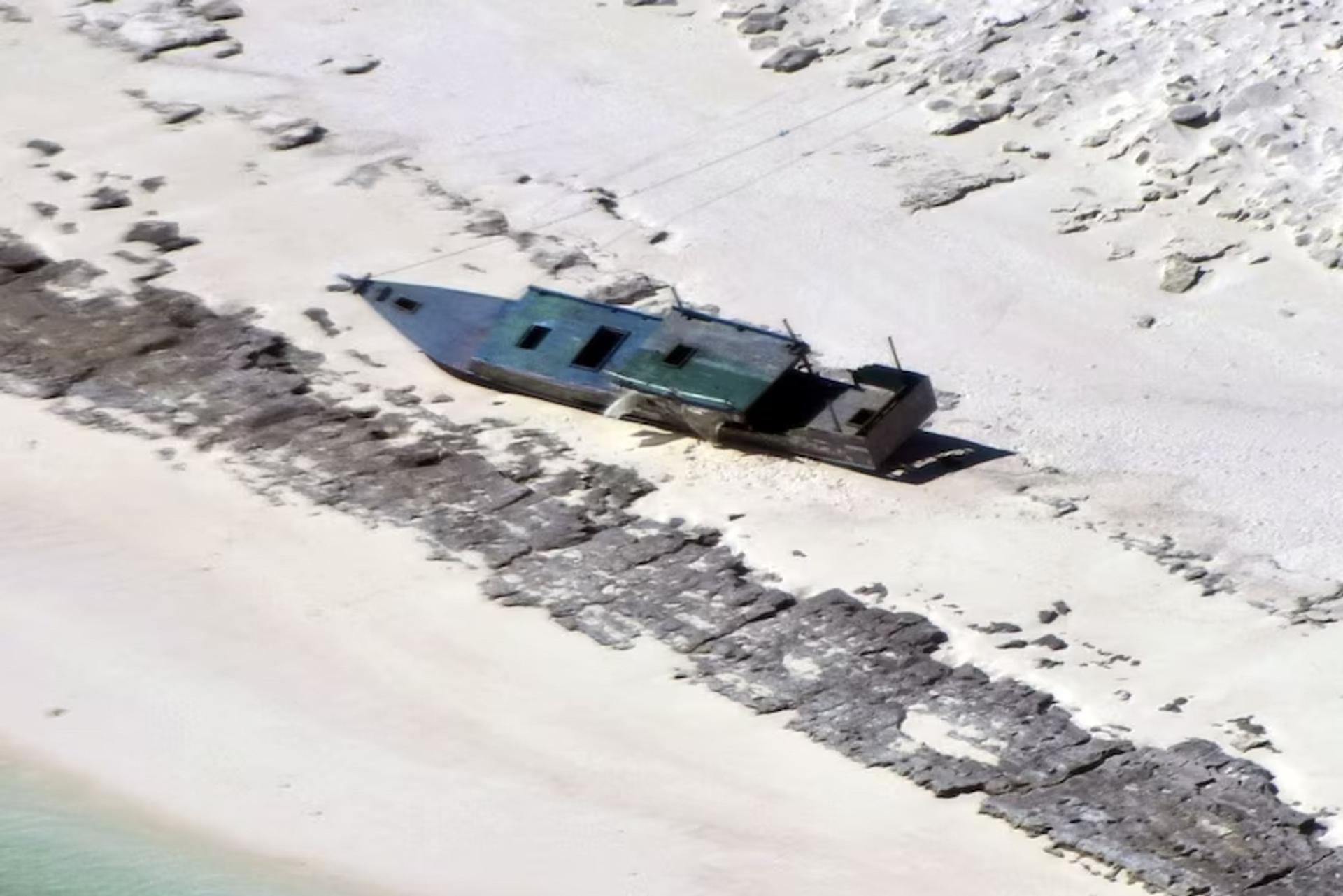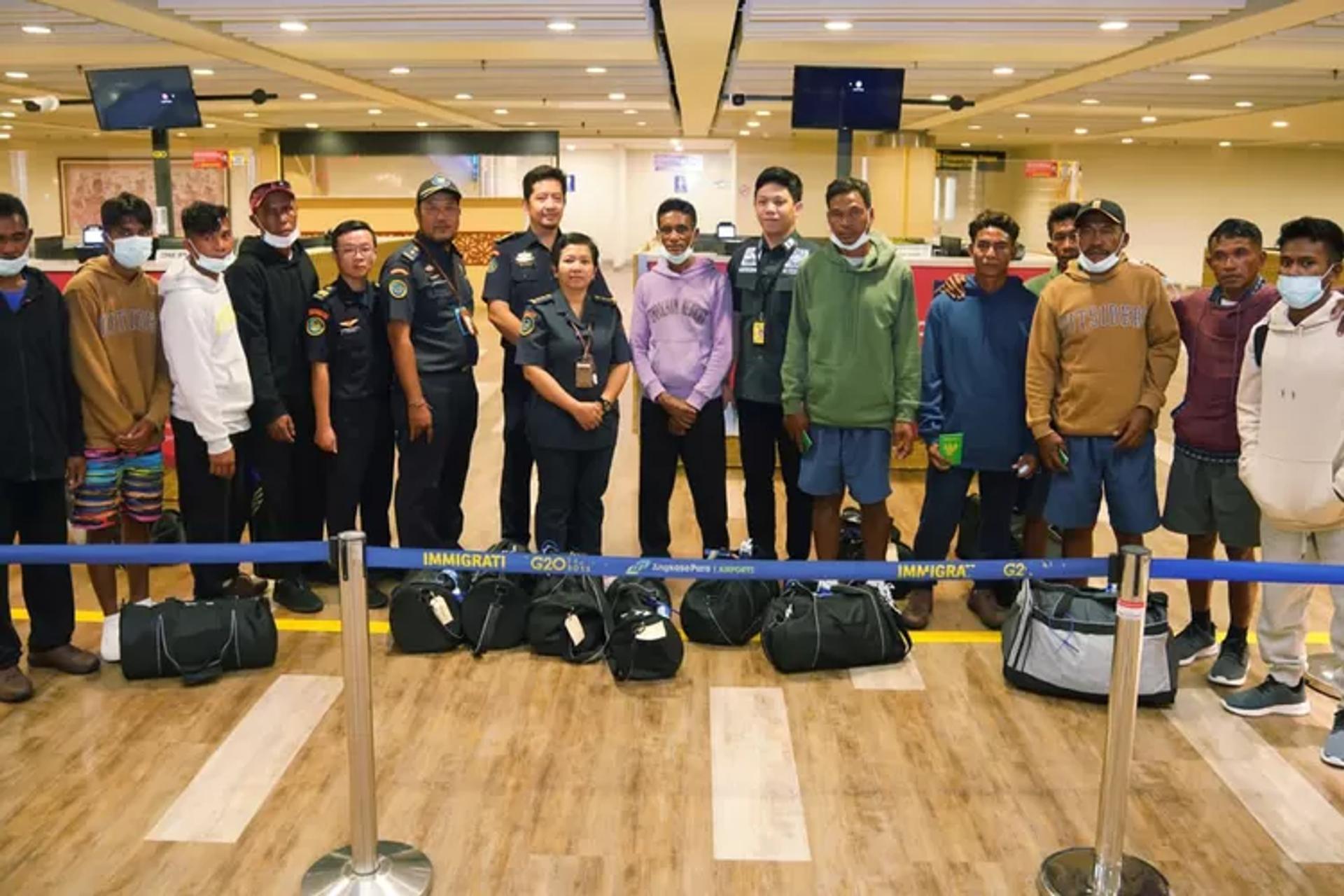Putri Jaya
Vessel Name: Putri Jaya
Arsad Saleh
Salman Kawak Jalanting
Safarudin Jalating
Harno Acing
Muhammad Yamin
Puling
Rendi
Junias Laifoy
Juven Rissi
Lost at Sea off Rowley Shoals as a result of Tropical Cyclone Ilsa
12 April 2023

The PM Dioskuri 01 beached on Bedwell Island

The Survivors from the ordeal returned to Indonesia
Indonesian fishermen from the island of Rote in West Timor, report they can reach the Rowley Shoals, a journey of 850 kilometres, in 3 days and 3 nights using GPS to guide them. They can gather a catch of trepang (Sea cucumber) in a matter of hours, and return back home. Higher prices for delicacies such as shark fin, trepang and reef fish across Asian markets lure fishermen to go to greater lengths to access these remote areas. The price of sea cucumber has been steadily rising. The reefs of northern Australia offer an abundance of these creatures that can be easily gathered. These are waters in which Indonesian fishers have been sailing for hundreds of years. Each of the main reefs with trepang has its Indonesian name; Ashmore is Pulau Pasir, Cartier is Pulau Baru, Scott Reef is Pulau Dato, and the Rowley Shoals are known as Pulau Bawa Angin.
The overwhelming majority of these fishermen come from a small number of fishing villages on the island of Rote. The largest of these villages is the mostly Muslim settlement of Papela at the eastern end of the island. It has been a gathering place for fishers for over 100 years.
Under a memorandum of understanding (MOU) between the Australian and Indonesian governments signed in 1974, “traditional fishermen” were given access to a “declared fishing zone” consisting of specific reefs to the south of Rote. The Australian government never defined who these “traditional fishermen” were except by the methods they employed: hence a requirement of access to the so-called “MOU Box” is that boats must only be sail-powered. This arrangement continues to the present. Each year a small fleet of sailing perahu known as “lambo” set out from the village of Oelaba to gather trepang and trochus at Scott Reef.
Since this kind of gathering expedition has been going on for decades, the annual catch has dwindled, and the sailing fleet diminished. This has created a temptation to gather trepang elsewhere either at Ashmore Reef, which was prohibited to Indonesian fishermen in 1989 when it was declared a national nature reserve, or in the Rowley Shoals, which was never included in the MOU agreement. In terms of the present agreement, fishers are also allowed to sail into the “MOU Box” to fish for shark fin. Some boats from Papela continue to do so. But these are not the best areas for shark fishing, and the trend in Papela has been to replace traditional sailing vessels with smaller motorised boats.
Indonesian fishermen report that when they are apprehended, their catch and equipment are seized and photographed along with their boats. Fishermen describe this as being “marked”. They are warned that if they are apprehended a second time, their boats will be confiscated and burned. Despite the dangers and the warnings, the expeditions continue.
On the 6 April 2023, at least four small fishing vessels left the Port of Papela in search of trepang on the Rowley Shoals. Two of the boats were the PM Putri Jaya and the PM Dioskuri 01. (Perahu motor or “PM” means motorboat in Indonesian). The PM Putri Jaya was owned by Azhar Harabiti and had 9 crew in total, led by Captain Arsad Saleh. A set of brothers were also onboard, as well as a Father and Son. The PM Dioskuri was owned by Simon Serra and had 10 crew in total. Both vessels were of a similar size of 4 Gross Ton. The other two boats that left at around the same time were the Cahaya Alor and the Tuan Muda. They had left for their fishing expedition during the Muslim holy period of Ramadan. The fishermen often owe a debt to the owner of the boat. Some of the owners support the families while the fishermen are at sea, and that debt has to be repaid when they return. Some are caught in debt traps until they repay their owners.
After 6 days of sailing, on 12 April, the PM Putri Jaya was hit by high waves and strong winds caused by Tropical Cyclone Ilsa. The waves hit the boat’s engine causing it to stall and the boat finally sank. Ilsa recorded peak gusts of up to 289 kilometres per hour – enough to break the Bureau of Meterorology’s equipment. The category-five system also set a preliminary Australian record with 10-minute sustained wind speeds of 218 kilometres per hour as it ripped directly over the top of both Rowley Shoals and Bedout Island. It was the strongest Cyclone experienced in the area for 12 years.
The sole survivor of the PM Putri Jaya was Badco Said Jalating (alias Rama Jalating) (25). At 3am he tied a rope to himself and to a large plastic container before jumping from the boat before it sank. At the time of abandoning the vessel he did not see the other crew members and believes they sank with it. After 30 hours floating at sea, Jalating finally saw land and headed towards it. It turned out to be Bedwell Island in the Rowley Shoals, 313 kilometres west of Broome. There he met 10 fishermen from PM Dioskuri 01, who had also been hit by Cyclone Ilsa but had managed to beach their stricken vessel on the island. The survivors from the PM Dioskuri 01 (the vessels reported name in the Australian press was Express 1) were;
Welhemus Bora’a (40) (Captain)
Ferianus Semuel Daan (45)
Yanuance Rifael Bella (48)
Ibrahim Pau (55)
Yandro Rano (36)
Sepri Rotte (17)
Sahbudin Mala (51)
Nikson Tomson Julianus Rissi (40)
Rahman Irwan Ndun (29)
Gad Doma (53)
The 11 fishermen survived for 6 days on Bedwell island by consuming raw fish and resorting to drinking sea water at times. Amazingly, they were detected by an Australian Border Force patrol aircraft on Monday 17 April, in a surveillance operation carried out several days after the cyclone had hit North-Western Australia. The patrol aircraft notified the Australian Maritime Safety Authority (AMSA) to investigate. AMSA found a makeshift camp and called an emergency team from PHI Aviation. PHI Aviation sent a helicopter from Broome to evacuate the fishermen. It was too sandy to land the helicopter and, with night falling and visibility fading, time was running out. The rescuers decided to conduct winch recoveries using a basket and the aid of night vision goggles. The survivors had set up shade and holes had been dug, likely to look for water. Their bodies were stressed and highly dehydrated.
After undergoing medical examinations at Broome Hospital, they were transferred to the Northern Alternative Place of Detention (NAPOD) immigration detention centre at the Hotel Frontier Darwin, awaiting repatriation. The 11 fishermen were designated as unlawful non-citizens (UNCs) and detained under the Migration Act 1958 for having entered the Australian fishing zone unlawfully. However, after considering several factors, including the trauma experienced by the fishermen, the Australian authorities decided to repatriate “without going through a court process”. They were repatriated via Bali back to their families in the small Indonesian villages of Papela and Daiama on Rote Island. As of Monday April 24, the Rote Island villagers reported that the Cahaya Alor and the Tuan Muda failed to return to the Port and it is unclear if they ever did.
In 2018 there were 210 Indonesian fishermen in Australian detention, many of them from the Port of Papela. It has been suggested that instead of putting money into surveillance and rescue, further investment could be made by the Australian Government into assistance and development programs for the younger generation on these Indonesian Islands to generate different income streams.
What seems to have been entirely forgotten is Australia’s commitment in the 1974 MOU agreement that was explicitly reaffirmed in 1989: “to make arrangements for co-operation in developing alternative income projects in Eastern Indonesia for traditional fishermen traditionally engaged in fishing under the MOU”.
